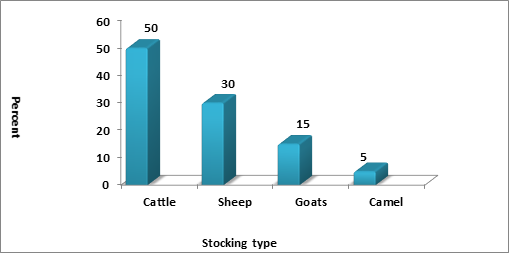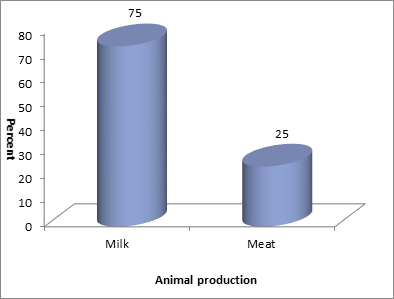Research Article
Volume 2 Issue 5 - 2018
Assessment of the Role of Natural Rangelands in Livestock Production in Shiekan Locality North Kordofan State, Sudan
Sudan University of Science and Technology, College of Forestry &Range Sciences, Department of Range Science, Sudan
*Corresponding Author: Hala Ahmed, Sudan University of Science and Technology, College of Forestry &Range Sciences, Department of Range Science, Sudan.
Received: January 09, 2018; Published: March 27, 2018
Abstract
This study was conducted at Shiekan Locality in North Kordofan State, Sudan during September 2007. The objective of this study is to investigate and assess the role of natural rangelands in livestock production. The information and data for the study were collected from livestock producers around ELA in community forest in Shiekan Locality. A Total sample size of 60 pastoralists was chosen to collect information. The results were presented in form of frequency distribution. The results showed that (46.7%) of pastoralists had ages ranging between 20-40 years. Also (83.3%) of respondents were illiterate. Regarding livestock feeding (63.3%) of pastoralists said animal feeding was adequate. About (73.3%) of respondents depend on Rahad as the main water source. About (50%)of pastoralists reported that they are cattle owners, while (30%) raise sheep (15%) rear goats and (5%) raise camels. About (75%) of pastoralists raise animals for production of milk, while (25%) keep animals for meat. Continuous movement of pastoralists from one place to another to search for forage and water during dry and wet season affected animals’ performance. Milk is a product for subsistence compared to meat production. Milk industry and marketing channels of milk should be promoted by relevant governmental sectors.
Keywords: Rangeland; Livestock; Production; Marketing; Prices
Introduction
The Sudan has an area of about 1,886,000 km2 and a population of 40, 97 million (WPR, 2017). It has about 106 million heads (MARFR, 2015). About 90% of livestock are raised in traditional pastoral systems, mainly in the states of Kordofan and Darfur which together host more than 60% of Sudan’s livestock.
The majority of breeds is raised within tribal groups and often carries the name of the tribe. They are well adapted to the harsh environment and often trek long distances in search of feed and water. Productivity is low but can be improved with good management in more favorable conditions (MAWF, 2005). Most native rangelands evolved under grazing. Therefore, rangeland plants have developed the ability to withstand a certain level of grazing or browsing pressure. Although grazing animals do disturb rangeland, research has shown that rangelands gain some benefits compared with a situation when livestock are totally excluded for long periods (Lyons and Hanselka, 2001).This leads to maintaining or improving the output of consumable range products, such as red meat, fiber, wood, water and wildlife (Holechek., et al. 2004).The area of North Kordofan is especially suited for extensive herding, compared to any other form of agriculture. Also livestock offers the best prospect of rapid economic growth for the families. Agriculture and livestock supply response is a very important issue on account of its impact on growth, poverty and environment. Not surprisingly, this issue is central in many structural programs in less- developed countries (Mamingi and Nlandu, 1997). The main objective of this study was to investigate and evaluate the role of natural rangelands in livestock production in North Kordofan, Sudan.
Materials and Methods
North Kordofan State lies in western Sudan between latitudes 11° 15¯–16° 45¯ N and longitudes 27° 5¯– 32° 15¯ E. It covers an area of approximately 190,840 km2, of which 70-80% is considered rangeland unsuitable for farming. Human population is recorded as 2.04 million (Population Census, 2008).
A field survey was started in September 2007 inorder to investigate and evaluate the role of natural rangelands in livestock production in North Kordofan. A sample size of 60 is generally regarded as the minimum requirement for larger population that will yield a sufficient level of certainty for decision-making (Poate and Daplyn, 1993). Community is considered appropriate as (Hinton, 1995) reported that a minimum sample size of 25 is acceptable for social survey studies.
The information and data for the study were collected from livestock producers at ELA in community forest, Shiekan Locality in North Kordofan. Sixty households were individually involved in answering the questionnaire. Range managers in North Kordofan State were also interviewed. The tribes represented were Hawazma, Bederia, Messeria, Gawama and Fallata. Most of the families raise cattle, sheep, goats and camels. Secondary data sources were websites, reports and books. After the data collection, the data were coded, summarized, tabulated and processed.
Analysis was conducted using (SPSS) computer program. The results were presented in form of frequency distribution. The Results were represented mainly in the form of descriptive tabular summaries according to (Steel and Torrie, 1960).
Results and Discussion
| Age | Frequency | Percent |
| 10-20 years | 11 | 18.3 |
| 20-40 years | 28 | 46.7 |
| 40-60 years | 18 | 30.0 |
| More than 60 years | 3 | 5.0 |
| Total | 60 | 100 |
Table 1: Percentage of pastoralist according to age.
| Education level | Frequency | Percent |
| Illiterate | 50 | 83.3 |
| Primary | 9 | 15.0 |
| Secondary | 1 | 1.7 |
| Total | 60 | 100 |
Table 2: Level of education of pastoralists investigated.
| Family movement | Frequency | Percent |
| Yes | 15 | 25 |
| No | 45 | 75 |
| Total | 60 | 100 |
Table 3: Percentage of respondents according to pastoralist members who move with the herds.
| Animal feeding | Frequency | Percent |
| Enough | 38 | 63.3 |
| Not enough | 15 | 25 |
| Moderate | 7 | 11.7 |
| Total | 60 | 100 |
Table 4: Percentage of respondents reporting adequate animal feeds.
| Water source | Frequency | Percent |
| Hafirs | 12 | 20 |
| Rahads | 44 | 73.3 |
| Others | 4 | 6.7 |
| Total | 60 | 100 |
Table 5: Main water source used by households in the area.
The result in table (1) shows that (46.7%) of the pastoralists are between (20-40) years of age indicating that the majority of those who look after animals are young. This confirms that nomads send young men with herds for long distances to graze in rainy season grazing area (Makharef). The results in table (2) show that (83.3%) are illiterate. This alarming rate of illiteracy may be attributed to the reason that nomads do not have permanent place, so it is difficult for them to go to school. In addition, they don’t send their children to schools, because they depend on them to look after the animals during the movement. The results in table (3) show that mostpas to ralists (75%) do not move with the herds while (25%) said they move with the herds. The relatively smaller percent of pastoralists migrating shade doubts about the real cause of illiteracy being migration. It supports the argument that pastoralists withhold their children from schools mainly because they need them to tend livestock. The results in table (4) show that most of the respondents (63.3%) said that there is enough feed, while (25%) of respondents said the feeding resources are not enough and (11.7%) reveals it is moderately available. The reason may be due to availability of natural vegetation in rangeland in addition to other alternatives in the form off odder trees which can be reached through their movement, when grazing is depleted in one location they move to another one that was not grazed.
The dominant species were Acacia tortilis, Acacia senegal (hashab), Faidherbiaalbida (haraz) which are also found with the dominant associated grasses of Eragrostistremula (Banu), Cenchrusspp (haskaneet) and Aristidaspp (gaw). The results in table (5) show that many of the respondents (73.3%) stated that the main water points were shallow seasonal natural water pools seasonal pond (rahads), while (20%) of respondents said the main water sources were hafirs and (6.7%) of respondents said the main water sources were wells and water yards (donkies) in dry season at South Kordofan. The result in figure (1) shows that about (50%) of the respondents own cattle, (30%) raise sheep, (15%) rear goats and (5%) raise camels. This may be attributed to that cattle, sheep and goats are adapted to conditions of the area, and in addition mixed herds are very efficient in exploiting the range resources. Moreover diversification in type of animal species reduces the risk of major losses in case of drought or diseases. Cattle raising is also considered prestige among these tribes. The result in figure (2) shows that most of the households investigated (75%) raise animals for production of milk and milk products, while (25%) of households reported that that they produce meat. The reason that most of respondents said they produce milk and milk products may be due to the sufficient number of animals they raise. The (25%) of respondents who said they produce meat also depend on milk in their daily meal more than meat. EL- Hag., et al. (2003) reported increased productivity of milk and increased growth by use of supplemental mineral blocks.
Conclusions
Milk is considered a byproduct and is not produced mainly for sale. Yet it takes an important place in the daily meal. Milk is a product for subsistence compared to meat production. Milk industry and marketing channels of milk should be promoted by relevant governmental sectors. The issue of illiteracy among pastoral groups requires serious attention from policy makers.
References
- ELHag F M., et al.“Analysis of livestock production condition in North Kordofan State, Sudan”. Basic research Journal of Agricultural Science and Review 2.8 (2003): 166-172.
- Hinton PR. “Statistics explained. A guide for social science Students”. London and New York (1995):
- Holechek JL., et al.“Range management principles and practices”. (2004):
- Lyons RK and Hanselka CW. “Grazing and Browsing: How Plants are affected”. The Texas A&M University System (2001): 6114.
- Mamingi and Nlandu. “The impact of price and macro-economic policies on agricultural supply synthesis of available results”. Agricultural Economics 16 (1997): 17-34.
- MARFR. “Ministry of Animals Resources, Fishers and Range. Information Center”. Statistical Bulletin 25 (2015):
- MAWF. “Ministry of Animal Wealth and Fisheries, Animal Population Report, Khartoum-Sudan”. (2005):
- Poate CD and Daplyn PF. “Data for Agrarian Development”. Cambridge University Press. Cited in Mari. F. M, 2009. Structure and efficiency analysis of vegetable production and marketing in Sindh, Pakistan (1993):
- Population Census. “5th Sudan Population and Housing Census-2008”. Priority Results (2008):
- Steel RCD and Torrie JH. “Principles and procedures of Statistics”. McGraw, Hill New York (1960):
- WPR. “World Population Review”. Accessed on 14 Dec 2017.
Citation:
Hala Ahmed., et al. “Assessment of the Role of Natural Rangelands in Livestock Production in Shiekan Locality North Kordofan
State, Sudan”. Innovative Techniques in Agriculture 2.5 (2018): 469-473.
Copyright: © 2018 Hala Ahmed., et al. This is an open-access article distributed under the terms of the Creative Commons Attribution License, which permits unrestricted use, distribution, and reproduction in any medium, provided the original author and source are credited.































 Scientia Ricerca is licensed and content of this site is available under a Creative Commons Attribution 4.0 International License.
Scientia Ricerca is licensed and content of this site is available under a Creative Commons Attribution 4.0 International License.